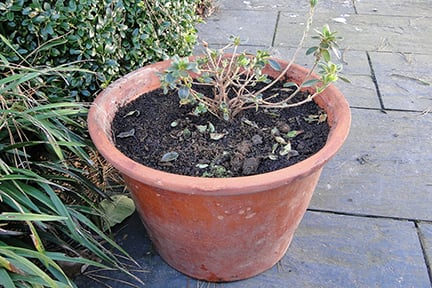
Quick facts
Suitable for - Container maintenance
Timing - When repotting (usually spring)
Difficulty - Easy
What is overpotting?
Overpotting is a term used to describe a containerised plant that has been potted into too large a container and is suffering as a consequence.
Using a large pot for a small plant doesn't necessarily lead to problems but where it can do is when the plant is not growing strongly, perhaps due to the time of year or slow rate of growth of that particular plant, or when there is a tendency to water too much.
How can I tell if a plant is suffering from overpotting?
In the short term after potting up, your plant is most likely going to look fine.
However, after a few weeks or months, some signs that the plant is not happy can begin to show. Watch for;
- Leaf yellowing
- Leaf browning
- Leaf fall
- Wilting
- Stunted growth
- Bronzing on evergreen such as box plants and yew
- Soggy on the surface of the pot
The reason the plant is showing signs of stress is because the large volume of new compost that was added when it was potted up is sitting wet for a long period, reducing aeration around the roots. Instead of the roots growing out into the new compost, they simply rot.
Although the compost will dry naturally through evaporation, it takes longer when there is a greater proportion of compost to roots. The more fresh compost there is, the more it will stay wet, creating a soggy ring around the . Finer growing medias that hold onto more water are particularly prone.
Plants that show some of the symptoms described above are often mistakenly wateredmore not less, thus adding to the problem. And if the overpotting was done late in the growing season (after June), rather than in spring, this too will mean it is exacerbated by slow plant growth and wetter conditions.
How to avoid or remedy overpotting
Avoidance
Ideally, it is best to avoid overpotting in the first place. Don’t be too generous. Stick to the rule of thumb of only potting into a slightly larger pot, not jumping into a significantly bigger one. This usually means a pot that is 2.5-5cm (1-2in) wider in diameter than the previous container and not much deeper (be careful if potting into deep pots such as ‘long toms’).
Or, if you know how quick growing your plant is, only pot into a container that you consider the roots will begin to fill by the end of the growing season.
Remedy
If you have already knowingly or accidentally overpotted there are two options;
- Leave it in the large pot but water extremely carefully, only watering when there are signs of the drying. This is particularly important in the first few weeks after repotting. Consider foliar feeding (i.e. a liquid fertiliser sprayed directly onto the leaves) to encourage growth without waterlogging. Go to stage two if symptoms appear.
- Gently tip the plant out of the large pot and allow any loose compost to fall away (it is a good idea to do this over some newspaper). Down size the plant into a container that is only just larger than the inner . The loose compost can be saved and used again. Water sparingly until there are signs of the plant recovering.











